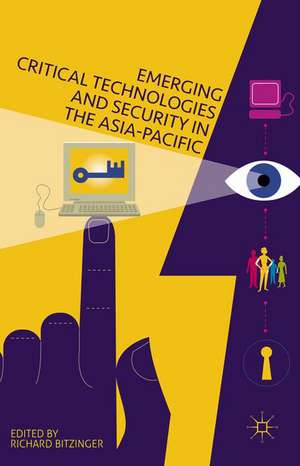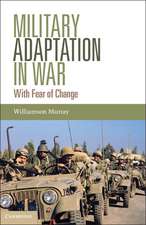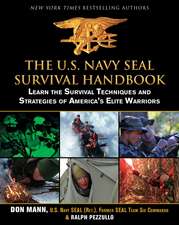Emerging Critical Technologies and Security in the Asia-Pacific
Autor R. Bitzinger, Kenneth A. Loparoen Limba Engleză Hardback – 12 oct 2014
Preț: 385.84 lei
Nou
Puncte Express: 579
Preț estimativ în valută:
73.83€ • 77.36$ • 61.03£
73.83€ • 77.36$ • 61.03£
Carte tipărită la comandă
Livrare economică 11-25 aprilie
Preluare comenzi: 021 569.72.76
Specificații
ISBN-13: 9781137461278
ISBN-10: 1137461276
Pagini: 169
Ilustrații: XIII, 169 p.
Dimensiuni: 140 x 216 x 13 mm
Greutate: 0.36 kg
Ediția:1st ed. 2016
Editura: Palgrave Macmillan UK
Colecția Palgrave Macmillan
Locul publicării:London, United Kingdom
ISBN-10: 1137461276
Pagini: 169
Ilustrații: XIII, 169 p.
Dimensiuni: 140 x 216 x 13 mm
Greutate: 0.36 kg
Ediția:1st ed. 2016
Editura: Palgrave Macmillan UK
Colecția Palgrave Macmillan
Locul publicării:London, United Kingdom
Cuprins
1. Emerging Technologies and Military Capability; Andrew D. James
2. The Potential Import of New, Emerging, and Over-the-Horizon Technologies; Andrew L. Ross
3. Absorbing New Military Capabilities: Defense Technology Acquisition and the Asia-Pacific; Martin Lundmark
4. Emerging Technologies' Potential to Change the Balance of Power; Asia by Eugene Gholz
5. Offsetting the Impacts of Emerging Critical Technologies; Virginia B. Watson
6. Effective Absorption of Emerging Technologies in Defense Automotives to Enhance Land-Based Military Capabilities; Kogila Balakrishnan
7. Diesel-Electric Submarine Modernization in Asia: The Role of Air-Independent Propulsion Systems; Michael Raska
8. From Subsonic to Hypersonic Cruise Missiles: Revolution or Evolution in Land Attack Capabilities?; Kalyan M. Kemburi
9. The Potential Military Impact of Emerging Technologies in the Asia Pacific Region: A Focus on Cyber Capabilities; Caitriona H. Heinl
10. The (Over)Promise of Modern Technology; Bernard Loo
11. The Future is upon Us: Failed Predictions, Boiling Frogs, and Gun Printers; Paul T. Mitchell
12. The Future Ain't What it used to be: Strategic Innovation in the Global Defense Industry; Richard A. Bitzinger
2. The Potential Import of New, Emerging, and Over-the-Horizon Technologies; Andrew L. Ross
3. Absorbing New Military Capabilities: Defense Technology Acquisition and the Asia-Pacific; Martin Lundmark
4. Emerging Technologies' Potential to Change the Balance of Power; Asia by Eugene Gholz
5. Offsetting the Impacts of Emerging Critical Technologies; Virginia B. Watson
6. Effective Absorption of Emerging Technologies in Defense Automotives to Enhance Land-Based Military Capabilities; Kogila Balakrishnan
7. Diesel-Electric Submarine Modernization in Asia: The Role of Air-Independent Propulsion Systems; Michael Raska
8. From Subsonic to Hypersonic Cruise Missiles: Revolution or Evolution in Land Attack Capabilities?; Kalyan M. Kemburi
9. The Potential Military Impact of Emerging Technologies in the Asia Pacific Region: A Focus on Cyber Capabilities; Caitriona H. Heinl
10. The (Over)Promise of Modern Technology; Bernard Loo
11. The Future is upon Us: Failed Predictions, Boiling Frogs, and Gun Printers; Paul T. Mitchell
12. The Future Ain't What it used to be: Strategic Innovation in the Global Defense Industry; Richard A. Bitzinger
Notă biografică
Richard A. Bitzinger is a Senior Fellow and Coordinator of the Military Transformations Program at the S. Rajaratnam School of International Studies (RSIS), Singapore. His work at RSIS focuses on security and defense issues relating to the Asia-Pacific region, including military modernization and force transformation, regional defense industries and local armaments production, and weapons proliferation.
Textul de pe ultima copertă
This volume addresses how 'emerging critical technologies' affect military capabilities, and therefore military advantage, in the Asia-Pacific. Technology is a crucial element of military effectiveness and advantage, particularly with regard to the Asia-Pacific region. Therefore, the proliferation of advanced conventional weaponry, and the subsequent increases in military capacity, has been a dramatic, and perhaps even alarming, development. Regional militaries have, in recent decades, acquired capabilities that were previously unknown. At the same time, the diffusion of militarily critical technologies, as well as the ability of militaries to exploit potential, varies widely across the region. Naturally, this unequal distribution will determine the impact of these technologies and capabilities on regional security and stability. Consequently, it is essential to assess the relative abilities of regional militaries and the impediments they may face.












